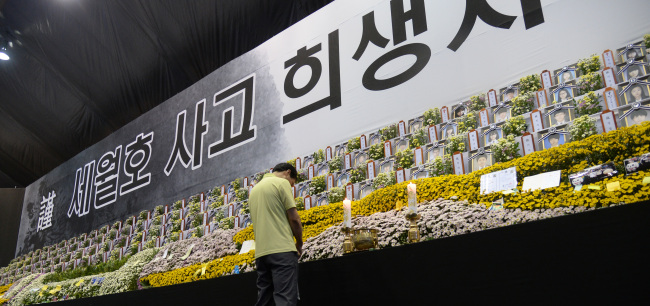This is the seventh in a series of articles that examine Korean’s preparedness for disasters and social risks in light of the recent Sewol tragedy. ― Ed.
Since the Sewol disaster took place, Park Ji-young, a 41-year-old office worker, has made it a habit to check where emergency door-opening handles are when taking the subway. She looks for fire extinguishers and emergency exits when she enters any building. At home, she talks about how to survive different types of disasters with her two daughters who are 9 and 11 years old.
Driven by fear that the state is no longer capable of protecting its citizens, Park said she was motivated to create her own survival manual and stay cautious.
Since the Sewol disaster took place, Park Ji-young, a 41-year-old office worker, has made it a habit to check where emergency door-opening handles are when taking the subway. She looks for fire extinguishers and emergency exits when she enters any building. At home, she talks about how to survive different types of disasters with her two daughters who are 9 and 11 years old.
Driven by fear that the state is no longer capable of protecting its citizens, Park said she was motivated to create her own survival manual and stay cautious.

“In the wake of the Sewol tragedy, I’ve realized that I should first learn how to survive and stop thinking that there will be someone else out there to protect me and save me,” she said, adding that she was struck by the Sewol crew’s irresponsible behavior in leaving nearly 500 passengers behind on the sinking ferry and Coast Guard officials’ poor initial response.
She was also disturbed by a recent arson attack on Subway No. 3 in Seoul. A 71-year-old man set a fire inside a subway car approaching Dogok Station on Line 3 in Seoul last week. The blaze was brought under control in less than six minutes by subway employees who were inside of the train at that time. No casualties were reported.
“I take that subway every morning and evening. What if it happens again? I should be prepared.”
Park is one of many people who now pay keen interest in self-protection and emergency preparedness. Some Internet users share survival kits and manuals on community sites. Safety products, such as life vests and anti-slip mats, are selling briskly.
This development is positive, experts say. But to stay alive in the event of a disaster or an accident, people really need actual, regular training rather than just mapping out how to prepare themselves in their heads.
Shim Jae-hyun, director of the disaster prevention team at the National Disaster Management Institute, stressed that people should know how to protect themselves in the first three to five minutes ― or the “golden time” ― before the rescue team arrives at an accident site. To do so requires constant training at schools, at home and at work.
Such training can save lives, even though it will take considerable time and money.
“Most people died, for instance during the Daegu subway fire, because they followed the people in front on them thoughtlessly,” Shim said in an interview with The Korea Herald.
“If only they knew that they should crawl along the floor where the air will be clearer and toward the opposition direction from were the smoke rises. … Many could have lived. But they didn’t know,” he said.
The government, so far, has published more than 3,000 survival manuals, most of which lack public attention. The director said the government should simplify the manuals and use multimedia platforms such as the Internet, movies and advertisements to raise public awareness that there are ways to survive.
“How many people know that they have to climb up the mountain when a flood rolls down the valley and that they have to find pillars or desks in the event of an earthquake? … These are the basics of the basics, but we have realized that not many people are aware of these measures.”
Shim claimed that the government should encourage schools, companies and parents at home to make good use of state-led civil defense drills. The Korean government stages civil defense exercises nationwide five times a year to prepare for any possible attack by the North and natural disasters. During the 20-minute drill, starting with a siren, all cars must pull over and people stay indoors.
“Rather than just staying indoors at home, school and in the office during the drill, the government must provide simulation programs to let people move and train themselves to prepare for different types of disasters and accidents,” he said.
Shim said people have the inherent ability to protect themselves but what matters is whether they take a closer look at survival methods.
“The human instinct to survive is a very powerful drive. But without proper knowledge and training, it will be of no use,” he said.
By Cho Chung-un (christory@heraldcorp.com)
-
Articles by Korea Herald




![[KH Explains] No more 'Michael' at Kakao Games](http://res.heraldm.com/phpwas/restmb_idxmake.php?idx=644&simg=/content/image/2024/04/28/20240428050183_0.jpg&u=20240428180321)














